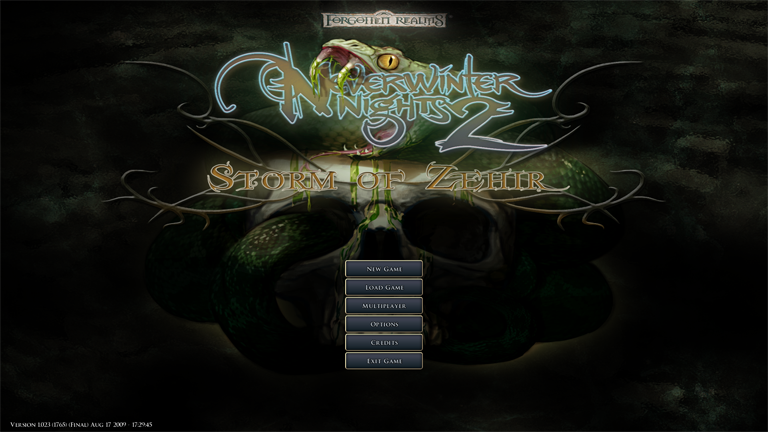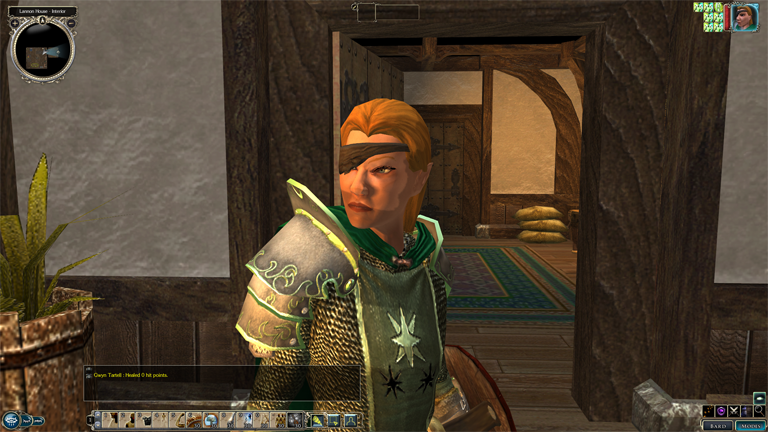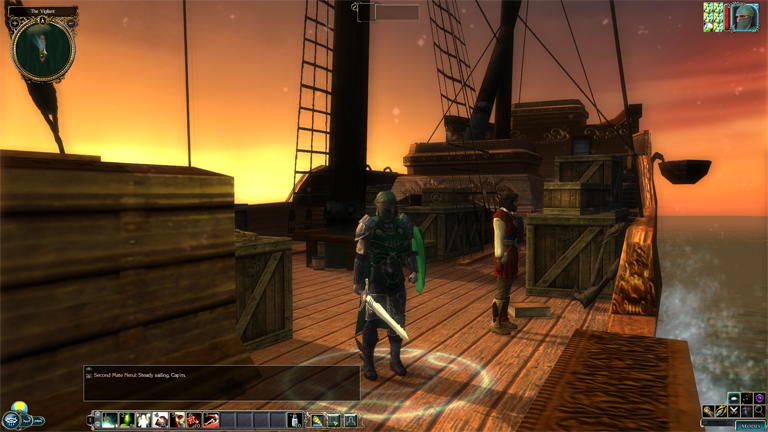From times immemorial (or the nineties, as I like to call 'em), computer RPGs have all suffered from two very basic flaws. First, a Lack of Continuity, which meant no matter how good your gaming experience was this time around, the very next outing would take place with new characters, in a different world. And second, Brevity (which, okay, wasn't so much a flaw as simply how life works but — still): even the best adventures eventually ended, leaving the player little recourse but to find some other game to play.
Some of the best computer RPGs tried to get around these shortcomings with sequels, of course, which gave us the excellent Baldur's Gate series and the great (for its time) Eye of the Beholder trilogy, but adding content did not solve the issues – it merely postponed their manifestation.
Anyway, solving these "shortcomings" was impossible, right? Developers could hardly be expected to keep producing content for an aging game ad infinitum, could they? The majority of studios agreed...
But one begged to differ.
BioWare seemed to not only consider these flaws solvable, but also had a concrete plan to tackle them in place. Said plan was realized in 2002 in the form of Neverwinter Nights – a single-player game, yes, but also a sort of DIY kit for (theoretically) infinite RPG adventuring.
Packaged with the stupendously user-friendly Aurora toolset, NWN could be used to construct easily accessible worlds which could then be enjoyed by up to 64 players via multiplayer. It was an unprecedented technical achievement which faithfully recreated D&D adventuring on a computer... There was only one problem: it was a boring game.
The original NWN campaign felt like a "dialogue, dialogue, dialogue – and then 1d4 kobolds appear!" box-set adaptation from the eighties, with wooden characters, haphazard world building and plot twists that couldn't be more obvious if they came with their own spoiler-ridden, neon-lit billboards...
BioWare did improve the dearth of atmosphere somewhat with NWN's first expansion, Shadows of Undrentide, but then shot itself in the foot by making the module a level one, introductory campaign (which sorta re-introduced the Lack of Continuity issue). The second expansion, Hordes of the Underdark, did a better job on that front, by letting you keep using your (by then) mighty-ish character from the original campaign, but the writing only marginally improved and the graphics engine was beginning to show its age.
BioWare kept publishing "premium" modules (of dubious quality) for a few more years, which never amounted to much, and then shifted its focus to Dragon Age and Mass Effect – leaving the RPG community with an awesome toolkit, a mediocre game and, once again, no one to champion the cause of overcoming those two, critical flaws...
But only for a couple of years.

The D&D community's salvation arrived from entirely predictable quarters when, in 2006, those wily rascals at Obsidian Entertainment dropped Neverwinter Nights 2 on the unsuspecting public. Finally, here was the answer to all those nagging shortcomings... Kinda.
NWN2 ran the uprated Electron graphics engine, for truly breathtaking visuals. It retained the multiplayer capacity of the original game and even offered an upgrade to the Aurora toolset (which, unfortunately, came with a fairly steep learning curve and was much less intuitive and harder to use than the original).
And best of all? It offered a truly epic campaign, which saw your character rise from a level one nobody to a respected ruler with lands, responsibilities and renown.

In true Obsidian fashion, NWN2 also came stock with poor optimization, increased system requirements and a host of bugs (which – for the most part, eventually – got ironed out), but in terms of gameplay itself, the sequel was a great improvement on the original. And things only got better from there.
Both official expansions to the game (by which I mean "still made by Obsidian") maintained continuity with the original campaign by keeping to the same world and characters introduced there, but both also offered something new to the established formula. Mask of the Betrayer did so through some of the best writing in RPG history (I'm not exaggerating here – as an expansion, it was still nominated for RPG of the year – a title it lost to The Witcher); excellent world-building, an intriguing cast of characters and new gaming mechanics.

Storm of Zehir, on the other hand, turned the classic NWN2 campaign on its head, offering an adventure with an RTS-style overland map, a business you could manage, lots of hidden locations to explore, and a whole new party skill system.
Even the third expansion, Mysteries of Westgate, while no longer helmed by Obsidian (but rather by Ossian Studios – the folks who made Darkness over Daggerford for NWN), offered an interesting and (mostly) enjoyable experience.
Ironically, in both NWN and NWN2, what promised to be the most revolutionary feature proved to be the most hit-and-miss. By outsourcing production of content to players, the games also all but assured that very little of said content would be well-made or all that enjoyable. Enthusiasm, unfortunately, is not enough to make a memorable module and – while some excellent exceptions have been created with the Aurora toolset – the majority fell prey to inconsistent writing, poor production values or game-breaking bugs. So while (theoretically) infinite adventures await in NWN and NWN2, in practice very few of 'em are worth undertaking.
Still, if you yearn for D&D adventures, the Neverwinter Nights series is probably the most exhaustive experience you can enjoy on a computer.
The first game, I would recommend more to builders. While BioWare never made that good a use of the Aurora toolset, it remains immensely user-friendly and straightforward, offering a fantastic mixture of ease (with its random, but interlocking tiles) and detail (with objects that can break the grid layout and create some truly lifelike environments). Even without user-created custom content, you can make practically any environment or setting in an hour or less.
If you like making your own adventures and running through them with friends, Neverwinter Nights Diamond is the way to go. Being older, it has lower system requirements, but – with a bit of Aurora elbow grease – can still look darn pretty in places.

In terms of gameplay, however, Neverwinter Nights 2 is king. Its character generator is superior – offering a vast list of races, deities, skills and feats to choose from (we're talking down to the eye color, height, girth, half-drow level of detail here) – and the three interlocking campaigns provide a vast, expertly crafted experience that will entertain you for at least 100 hours. Honestly, between gameplay that leans a little harder into dialogue and introspection (in Mask of the Betrayer, anyway — thanks, Chris Avellone!); several in-game crafting systems, a long list of character classes that can be combined in truly potent, creative ways, side quests galore and more than a few secrets, there's a lot to like in NWN2, gameplay-wise.
If you're ever in the market for a great RPG with tons of additional content (of, admittedly, varying quality), the two Neverwinter Nights games are as good as it gets, can be gotten relatively cheaply on GoG and enjoyed easily with friends via co-op. Just make sure to get Neverwinter Nights Diamond, if you can: the "enhanced", Beamdog "remake" adds a lot of unnecessary "refinements" and "improvements" (as Beamdog "remakes" are wont to do).
Recommended Modules:
Quirky pig that I am, I am not a fan of additional HAK packs/resources (as they tend to be module-specific, which sorta kicks the whole "continuity" bit in the head). As such, modules I enjoyed tended to do their best with base-game resources or (at most) some additional music or dialogue.
-
-I had a tough time finding an enjoyable module for NWN; Darkness over Daggerford is pretty even-keeled, but as it was made by Ossian (who went on to be "proper" devs), I'm not sure how "community made" the module actually was; a lot of module authors tended to either make static, linear stories with pre-determined PCs (which — why would you?) or elaborate concoctions composed of six to eight different HAKs (which would then strip equipment or abilities from your character when imported into a different module lacking those resources); to this day, I pay the NWN Vault a visit every now and again, but the pickings are fairly slim;
-
-for NWN2, I liked Harp and Chrysanthemum and The Birthday (by Maerduin) a great deal; while they were quite brief (a few hours each, at most), both were expertly made – with a level of care that included "examined" character descriptions, custom items and a pleasant cast – and so good, I hope Maerduin went on to find work in the industry;
